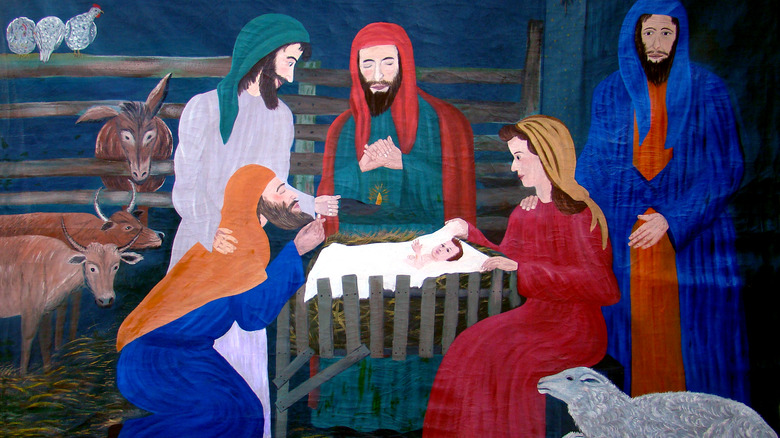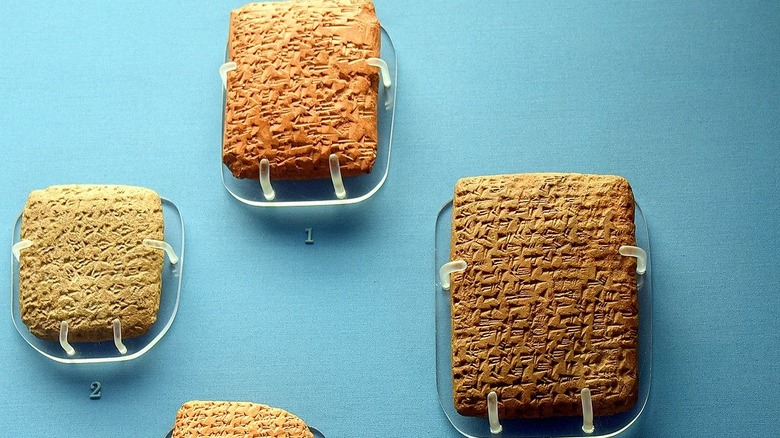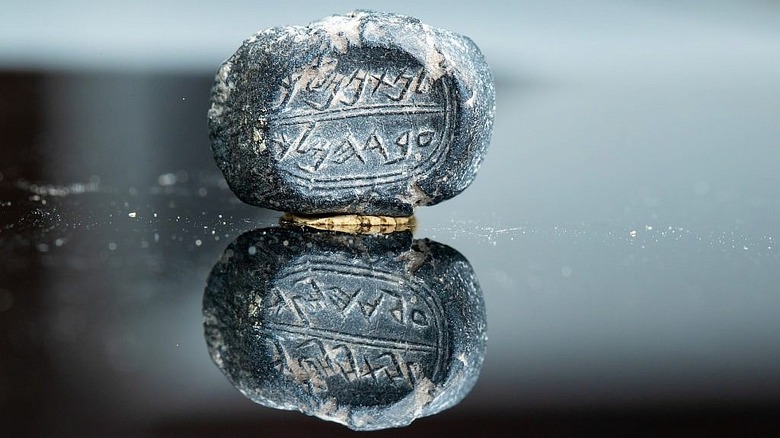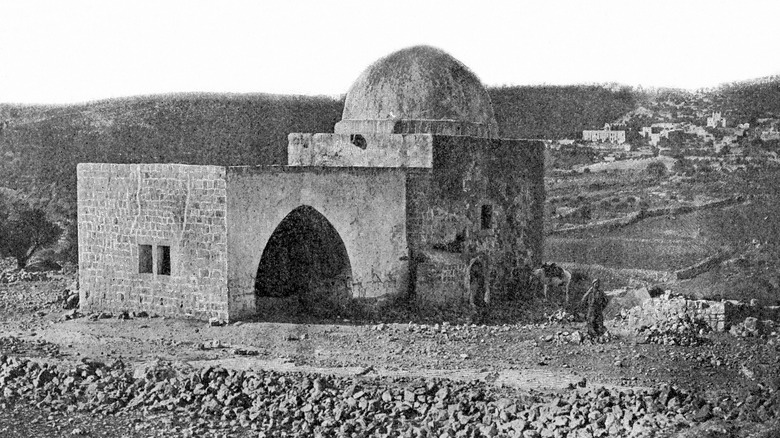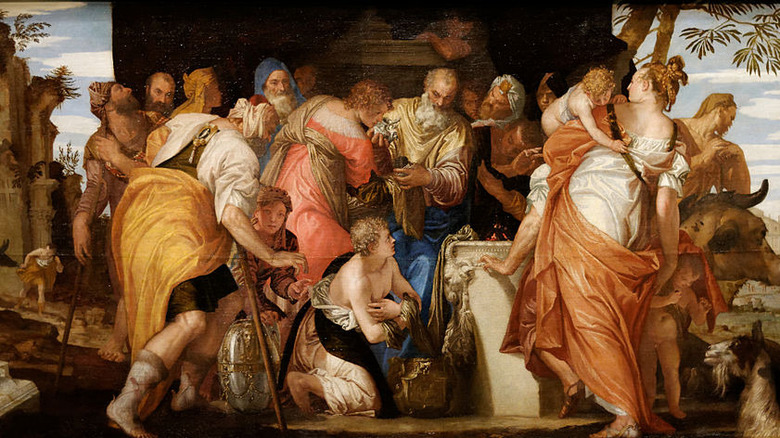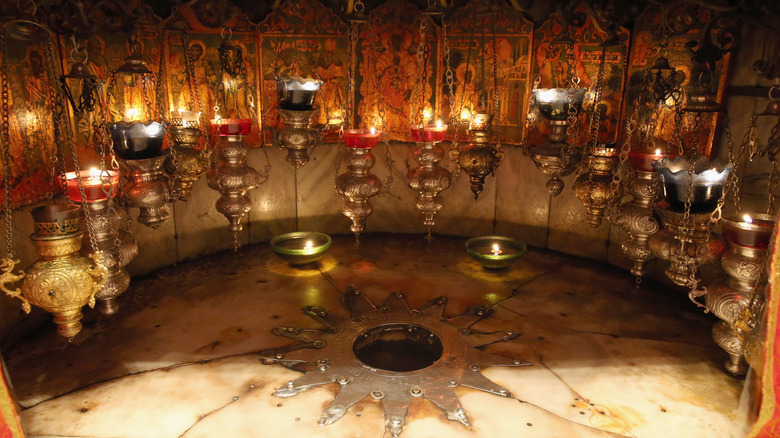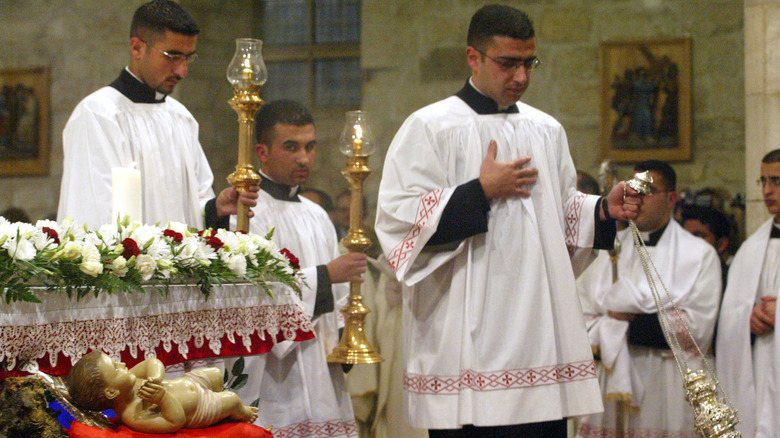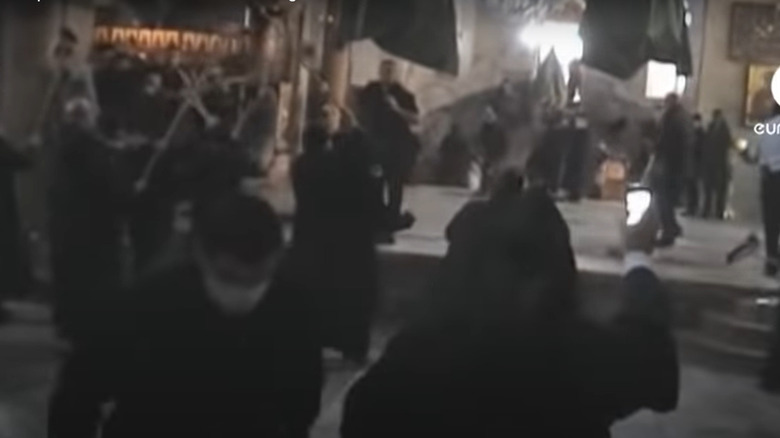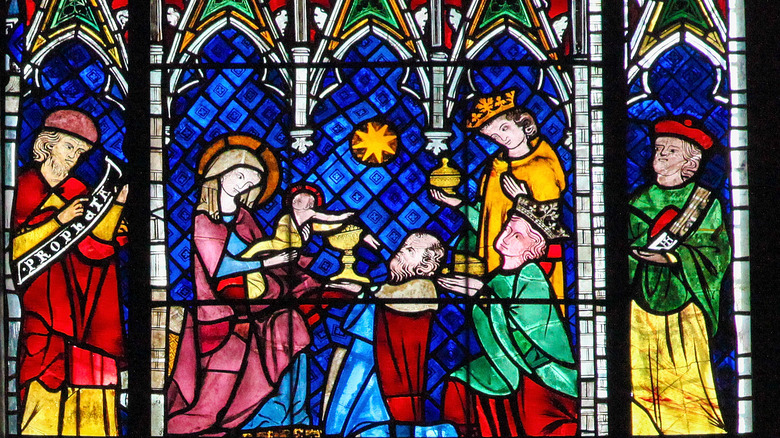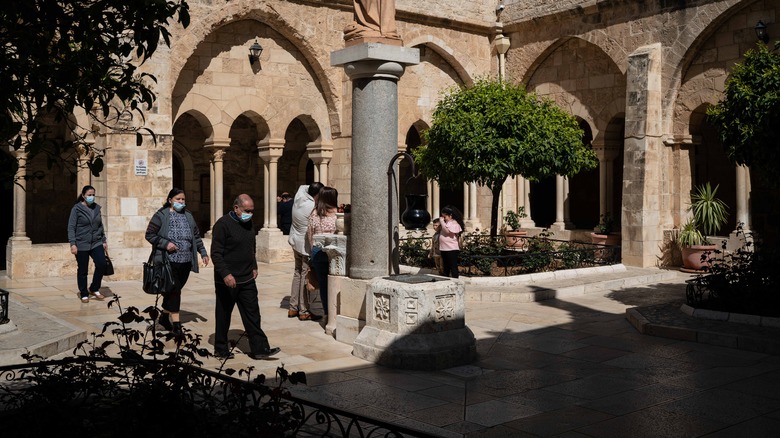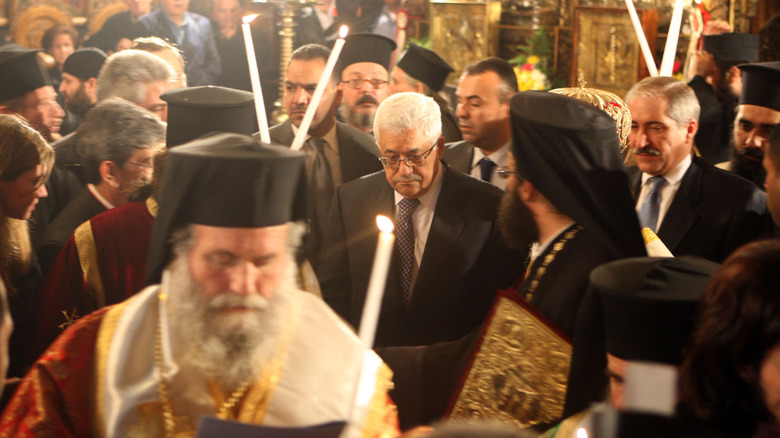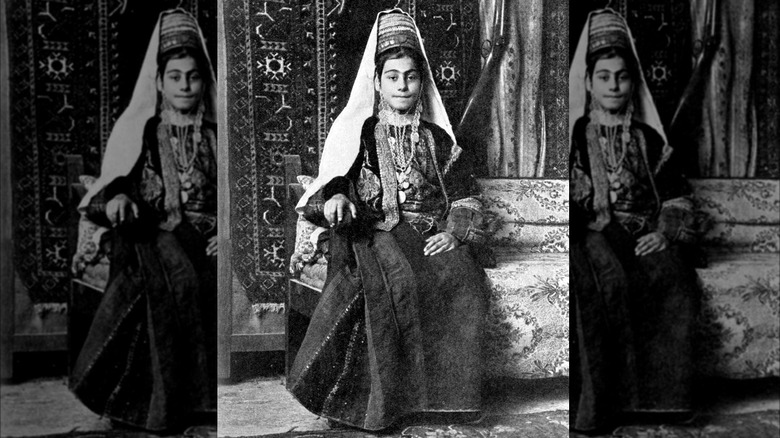The Untold Truth Of Bethlehem
When people think of the holiest sites in the Christian religion, two in particular come up. First is Jerusalem, the site of Jesus' ministry, death, and resurrection. For Catholics, Rome naturally comes up, as it contains the Vatican, where the Catholic Church's spiritual leader, the pope, lives. But there is another place that is equally as important as these two famous pilgrimage sites. This is none other than the small city of Bethlehem. It is Jesus' birthplace, and for Christians, where salvation came to earth in the form of a baby boy.
Now, most Christians are familiar with the general significance of Bethlehem. But Bethlehem contains many more surprises. Aside from Christ's birth, the town is associated with other biblical figures revered by Jews, Christians, and Muslims alike. It is a town that produces beautiful crafts, pageants, and processions, showcasing to the world that war and strife cannot completely destroy beauty and history. Here are some of the untold truths and hidden gems of Bethlehem's long and storied history.
It means different things in different languages
The town of Bethlehem has a history dating back thousands of years. As a result, many groups — from Canaanites, Israelites/Jews, and modern Palestinians — have left their imprint on the town. This long history is reflected in the town's name, which fascinatingly, is nearly identical in two closely related languages. Yet, it has three possible meanings.
The original name, which persists today in English, essentially originates from the Hebrew words for "bread" and "house." Thus, according to the Christianity Magazine, the name "Bethlehem" means "house of bread." For Christians, the name recalls the title of its most famous native, Jesus Christ, even though it was called that before his birth. According to the Gospel of John, Jesus is the "bread of life." Thus, one went to Bethlehem to receive the bread of life — Jesus himself, per World Council of Churches. Interestingly, "Bethlehem" can also mean "house of war" in Hebrew, since both bread and war come from the same root. In Arabic, Bethlehem means "house of meat." According to Christianity Today, the name might refer to the importance of animal husbandry and meat production. This is the interpretation of the name that has stuck in the Arab-speaking world today.
It might be attested in the Amarna Letters
With such a rich written record in the ancient Near East, one would expect to find some evidence for Bethlehem's existence outside the Bible. Unfortunately, pre-biblical references to Bethlehem are rare. In fact, there may only be one reference to the town in the written record from Egypt.
The Amarna Letters are a cache of texts found in Egypt that detail the correspondence of Egypt's pharaoh with numerous foreign rulers. Amarna Letter 290, sent from the ruler of Jerusalem, mentions a place called "Bit-Ninurta" (written e2-Ninurta). According to Douglas Waterhouse, this place and several other towns abandoned the ruler of Jerusalem, who needed help retaking them. He requested aid from the pharaoh for this endeavor. Archaeologist William Albright notes that some have identified this town as Bethlehem, although it is an admittedly unclear interpretation. Were it true, it would be a confirmation for the town's existence and importance even before biblical times.
Unfortunately, there is little evidence that Bethlehem is mentioned in the letter. In fact, Albright, Waterhouse, and scholars in general reject this equation, identifying this Bit-Ninurta with a place called Beth Horon instead. Thus, the textual record does not seem to contain any references to Bethlehem. Archaeology, on the other hand, has revealed more promising evidence.
Archaeological evidence confirms its existence in biblical times
While the reference in the Amarna Letters is not a reliable mention of Bethlehem, Israeli archaeologists have discovered archaeological evidence that confirms the town's existence before the time of Christ. The Presbyterian Times reported in 2012 that excavations in Jerusalem had unearthed a piece of an administrative seal inscribed with the words "Bethlehem," "seventh," and "king." Director Eli Shukron, interviewed in the Presbyterian Times, has proposed, based on the seal's inscription, that the artifact was an administrative item used to stamp tax shipments sent to the royal seat in Jerusalem. Thus, in the eighth or seventh century B.C., the town was paying tribute to the kings of Judah and was important enough that its officials had their own seals.
Shukron cautioned that the aforementioned Amarna reference is uncertain and could technically refer to another Bethlehem. Therefore, this seal would be the first certain mention of Bethlehem of Judaea (as opposed to Bethlehem of Galilee), Jesus' birthplace. Although Bethlehem seems to have had some economic importance back then, it is not particularly famous for those reasons. Instead, Bethlehem's original fame comes from its links to two other important Jewish biblical figures apart from Jesus: the matriarch Rachel and King David.
Rachel is buried there
Bethlehem is mentioned in the Bible well before Jesus. The first mention is in Genesis in the context of the burial of one of Jesus' distant relatives, the matriarch Rachel. Her tomb, originally on a lonely roadside in the middle of nowhere, is shrouded in a beautiful tradition and has attracted controversy as of late due to its disputed status. Chabad affectionately refers to the matriarch as "mama Rachel," the archetypal Jewish mother that sacrificed everything for her children. According to Jewish tradition, Jacob had a vision of his suffering descendants crying out to her. So when she died, he buried her along the road so her suffering children would pass by and beg for her intercession with God. The language used to describe her reveals a deep Jewish reverence for the matriarch. Thus, Israel has controversially insisted on retaining control of the tomb.
The tomb has seen its share of violence because of its centrality to Jewish tradition. According to Chabad, Jordanian forces banned Jewish prayer at the site in 1948. Today, according to the city website, Bethlehem is part of the Palestinian Territories. Israel, however, has retained control of the tomb itself. According to the Times of Israel, Palestinians have attempted to bomb the tomb, so access is strictly controlled through a series of checkpoints, including a mini-fortress of concrete built around the structure (picture is from before the barrier was built). To avoid trouble between Jews and Muslims, Israel has even restricted Jewish prayer at the site.
Later, it was King David's birthplace
Rachel is not the only major Jewish figure associated with Bethlehem. The town was also the home of a young shepherd boy and ancestor of Jesus named David. Those familiar with the biblical narrative recall that the diminutive David was selected over his elder brothers to become king of Israel, despite his humble station in life. According to Christian Foundations, he was anointed in Bethlehem. Thus, David became closely associated not only with Jerusalem, his capital, but with this small rural town that provided Israel with its king.
As a result, Bethlehem is also called the "City of David" alongside Jerusalem. According to the Franciscan Foundation for the Holy Land, this moniker ties King David together with his descendant, Jesus Christ. The foundation notes that per Christian belief, Jesus was not born in Bethlehem by accident. It was divine will. The Hebrew prophets Isaiah and Micah predicted that the messiah would be a descendant of David and therefore had to be born in Bethlehem, the City of David. Just as David had come out of humble Bethlehem and ruled over the united tribes of Israel from Jerusalem, Jesus would come and unite all peoples in the Kingdom of God.
Jesus birthplace: Cave or stable?
Christianity's pivotal event finally occurred 1,000 years after David's birth. Jesus was born in a stable in Bethlehem. At least, this is the popularly imagined scene. It has become seared into American and Western imaginations through numerous nativity sets and scenes. But was a Bethlehem stable really Jesus' birthplace? Bethlehem's Church of the Nativity suggests that it was not.
So where was Jesus born? According to Catholic World Report, the Church of the Nativity is built over a grotto or cave, believed to be the exact spot where Jesus was born and laid in the manger. These caves were not just any caves. They served as shelters to shepherds and their flocks when they were out grazing in the fields. Even today, shepherds in the Holy Land use them, and according to the Chicago Tribune, children have been born in them.
Christian tradition actually agrees with the cave story, although it has been mostly forgotten among Christians. In fact, according to CNEWA, many Christian pilgrims to the church are surprised to learn this fact and are in denial about the humble setting. But Justin Martyr, an early Father of the Church, corroborated the tradition of the cave birth. As a native of nearby Nablus, he would have known the area and its traditions well, so his testimony should be taken seriously.
The Church of the Nativity is shared
Christians are generally in agreement that Jesus was born in Bethlehem in the grotto under the Church of the Nativity. However, they are not so united on sharing access to the site. The competition over worship space between three major denominations has resulted in an interesting sharing agreement that has been in force since the 19th century.
According to the Guardian three controlling churches have divided the complex among themselves. The Greek Orthodox Church holds approximately 80% of the property and is the majority shareholder. The Roman Catholic and Armenian Apostolic Churches own the rest, including the grotto.
To ensure peace between the three churches and put an end to the squabbles, the Ottoman Empire in 1852 instituted the Status Quo. According to the Catholic Register, this balance, which is still in force today, means that the different denominations adhere to a strict schedule, ensure that each others' services begin on time, and avoid touching each other's stuff unless they are willing to care for it later. This applies to everything from chapels to candles. They are all expected to chip in for repairs too, allowing a restoration project to fix damage to the church's interior and roof to finally begin in 2016. The Status Quo generally works, but that doesn't mean that flare-ups have not occurred occasionally.
Church of the Nativity fight club
Although the church is shared today, the fact that the Ottoman Empire had to impose the Status Quo suggests that there have been arguments over control of the church that have sometimes exploded into violence and in one case, war. Boston College scholar Raymond Cohen notes that the church passed between Catholic and Orthodox hands for hundreds of years as Byzantines, Latin crusaders, and the Muslim rulers of Jerusalem fought over control of the church.
Often, Muslim rulers, such as the Ottomans, would even transfer parts of the building to other churches depending on political whims. Cohen notes that sometimes, the empire favored its Greek citizens, while other times, it gave Catholics primacy, usually under French pressure. Following the imposition of the Status Quo in 1852, the peace held, apart from "the odd murder and riot," of course.
The fight over the church even helped ignite the Crimean War in 1853, a mere year after the Status Quo was enacted, according to History Today. France and Russia favored the Catholic and Orthodox churches' claims for primacy and guardianship of the church, forcing the Ottoman Empire to pick sides. Fortunately such disputes result in tamer incidents today, of which one stands out. According to NPR, tempers flared between rival groups of priests and monks in 2011 before Christmas. They proceeded to beat each other up with brooms before Palestinian police broke up the fight. It seems that someone had encroached on another church's space. Although such incidents are embarrassing, they are definitely preferable to war.
The Magi saved it from being destroyed in 614 A.D.
The damage to the Church of the Nativity is nothing new. Despite its importance, or perhaps because of it, the church has been burned and looted on multiple occasions. Smithsonian Magazine notes that a Jewish-Samaritan revolt against the Byzantines in 529 A.D. damaged the original church so badly that it had to be rebuilt. But one set of invaders decided to spare the church, perhaps out of reverence to some of their own people depicted inside the building.
According to historian Steven Runciman, forces of the Persian Empire invaded the Byzantine Empire's territories in 614 A.D. Persian forces fanned out across the countryside, sacking and looting churches for their many valuables on their way to Jerusalem. Eventually, they arrived in Bethlehem and prepared to loot the Church of the Nativity.
Upon arrival at the church, the Persian commander Shahrbaraz noticed something he had not expected to see. Covering one of the doors was a mosaic depicting what appeared to the general to be three Persians. These were none other than the Magi (aka the Three Wise Men), who according to Encyclopedia Iranica, were Persian Zoroastrian priests. Seeing his fellow Persians on the door, Shahrbaraz spared the church, not wishing to damage the mosaic. Unfortunately, it does not seem to have survived the ravages of time.
Bethlehem is a historically Christian town now in decline
Despite Bethlehem's Christian associations and history, there are fears that the Christian community is in danger of disappearing forever. Historically, Bethlehem has always had a Christian majority. According to the National Catholic Reporter, over 85% of the town's inhabitants were Christians of various denominations in 1950. By 2016, that number had declined precipitously to 12% and probably is less now. The worrying changes in Christian demography are due to mostly economic factors combined with a tense political situation.
The NCR notes that Christian communities face high rates of emigration due to unemployment and instability. Economic and educational opportunities are fleeting in the Palestinian Territories but are plentiful in neighboring Israel and in Western countries. For example, the Gotham Gazette details the success of Arab Christian emigration to New York, where many have assimilated easily into Western society and enjoyed a higher socio-economic status. According to the Times of Israel, they are also among Israel's most educated, despite representing a mere 2% of the population.
But this success abroad has come at a price. According to Newsweek, while the Christian population has fallen, the Muslim population, with its higher birth rate, is growing. Pope Francis has determined that there will be no Middle East without Christians, so steps must be taken to create a safe environment for the world's oldest Christian communities and discourage emigration. Bethlehem's first female mayor, Catholic Vera Baboun, made this a central part of her platform, linking the well-being of Bethlehem's Christians to the town's overall economic health.
Christmas is celebrated three times
Despite the collapse of Bethlehem's Christian population, the town is still a place of pilgrimage whose remaining Christians take their faith very seriously. Since Bethlehem is Jesus' birthplace, naturally, Bethlehem's most celebrated holiday is Christmas. But according to the New Arab, Christmas in Bethlehem is celebrated not once, but thrice, owing to the sectarian diversity among pilgrims and the local Palestinian community. Palestinian Christians and pilgrims belong to a myriad of denominations, including Catholics, Orthodox, Armenians, and Protestants. Over time, the various churches have developed calendrical differences that affect the celebration of Christmas. Thus, the holiday is celebrated three times with approximately two weeks between each iteration.
The first Christmas celebration occurs on December 24-25, the holiday's standard date on the Gregorian Calendar. The Orthodox and Greek Catholic Churches, which use the Revised Julian Solar Calendar, celebrate the holiday on January 6-7. Finally, the Armenian Apostolic Church uses the old Julian Solar Calendar, with Christmas falling on January 19.The multiple Christmas celebrations result in a month of festivities, processions, and masses/liturgies. The festivities are attended not only by clergy and faithful but also by local politicians, including presidents Mahmoud Abbas and Yasser Arafat. The different dates for Christmas ensures that the Status Quo Agreement can be maintained, since churches do not compete with each other for space.
Bethlehem is famous for its wedding dresses
According to the Middle East Eye, the Palestinian territories are generally known for their production of embroidered clothes, particularly dresses for women. Bethlehem, despite being primarily a pilgrimage site, is no exception. But unlike its traditionally Muslim-majority neighbors, Bethlehem has preserved a unique style of embroidery that is best seen on bridal wear.
According to the Library of Congress, Bethlehem holds a special place in the world of Palestinian embroidery for being one of the few place where women professionally produced bridal dresses for the surrounding regions. Such was the esteem people had for their handicraft. But Bethlehem's dresses contain one feature that is absent from the surrounding areas. The town's seamstresses' famous technique involves couching gold or silver thread onto their base materials to produce beautiful floral and linear patterns that do not have any counterparts in the region. Instead, they appear to hearken back to Byzantine times. It has been hypothesized that this design was in imitation of the richly embroidered robes and vestments worn by Byzantine priests. Naturally, such an influence would have been absent from majority-Muslim villages. Fortunately, this hidden gem of the Holy Land has been preserved today for people to admire, enjoy, and most importantly, wear on that special day.
